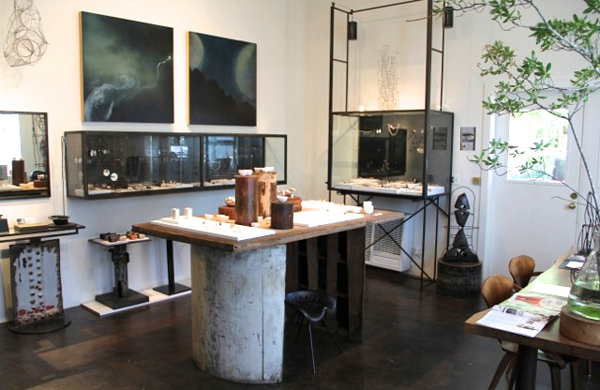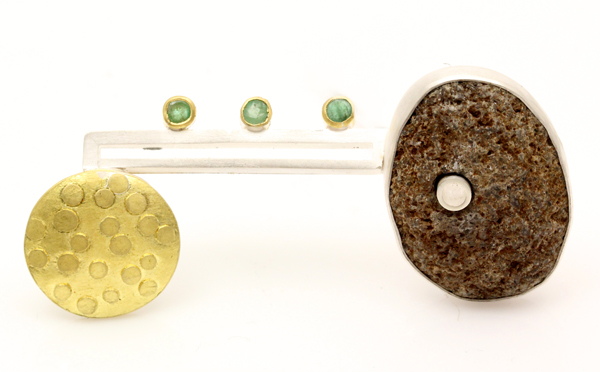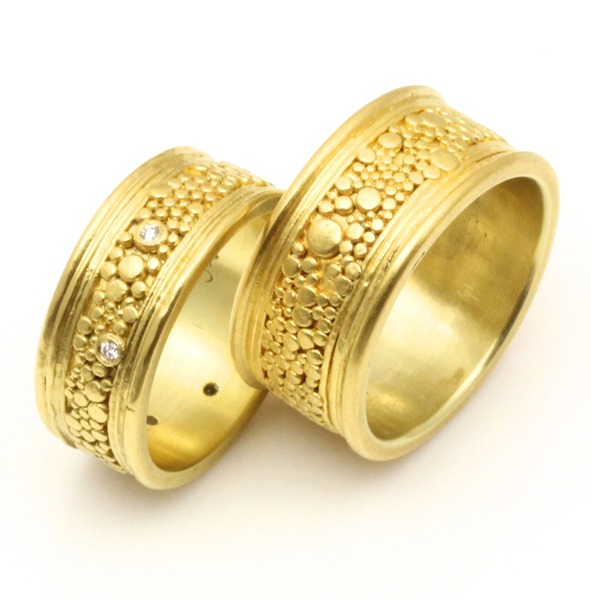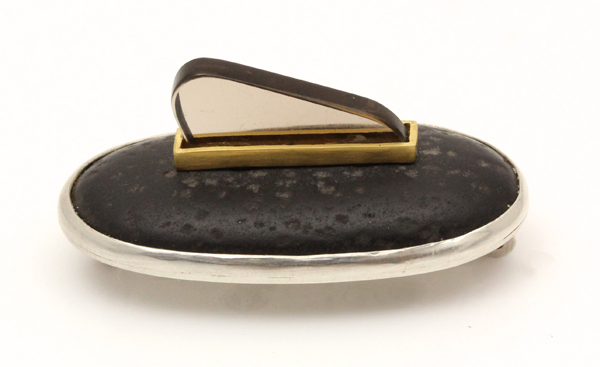
Susan Cummins: I know we have worked together in the past, but please refresh my memory about how you got to be the owner of a jewelry gallery.
April Higashi: I’ve been making jewelry for twenty years. Even in the beginning when I was first starting to make jewelry, I always thought about how it would be shown, grouped together or how it could be worn. When I worked at your gallery (Susan Cummins Gallery, Mill Valley, California) you instilled in me the importance of thought, idea and craftsmanship in each piece. While there, I realized how much I enjoyed aesthetically arranging and grouping the work. I also realized during that time how much I liked working directly with clients. So I knew I would enjoy curating a gallery. When my husband and I were looking to buy a house we found a building that was zoned for partial commercial use. The space was large enough to have both a workshop/studio and a gallery on the bottom floor. With this set up I felt I could continue to be a jewelry maker as well as take on a new role as curator and gallery owner. Originally I was thinking I would only do the gallery part-time. The reality, however, is that I have ended up creating two full-time jobs for myself. Fortunately I am a good delegator and so I have also ‘curated’ an amazing creative team to help me.
Is it just a jewelry gallery or do you show other things as well?
April Higashi: The focus of the gallery is contemporary art jewelry with some three-dimensional work. My husband is a sculptor and we show his work as well as work by other sculptors. I also show a few select clothing designers whose work is one-off or limited quantities and who come from a more hands-on background in textiles. I think it’s interesting to try to get people who wear artful clothing to wear artful jewelry. The link is actually not obvious to most of my clients, which surprised me. Occasionally I do show paintings and flat or two-dimensional art, but it is usually to compliment the aesthetic and feeling of one of the jewelry shows.
How is it working for you to have your home, studio and gallery in one place?
April Higashi: I would say that we are the true example of integrating LIFE + WORK. We have a two year old and the only way I could do as much as I do and be a mother is because he is just a floor away from it all. So mostly I like it. But there are days that I want to get away from it. For that, I travel.

Often the integration of life and work seems to continue more out of necessity than choice. I have to devote time to making new pieces and evolving as an artist in order to make a living. But I am happy to be reminded that it is a choice I’ve made and the lifestyle I have chosen.
What are the criteria you use to find artists work for the gallery?
April Higashi: I find artists to show at Shibumi Gallery through both my working and social relationships. Usually we meet at shows or because I’m so immersed in the art jewelry world our paths will inevitably cross at some point. On occasion I see a piece of work that makes me track down an artist.

It’s important for me to represent people I believe in and whose perspective I respect. I show around 40 artists and I have been told that there is an overlapping aesthetic among the artists I show. It is also important to me that they are craftspeople and makers, not just designers who work on the computer or paper. I like artists who pull ideas from the depths of themselves and don’t just follow trends. To me this often ensures that their work will continue evolving in new and interesting directions.
Who are your clients?
April Higashi: My clients are artistically minded, usually non-traditional, critical thinkers, often leading an ‘individualistic’ lifestyle. They are people who value work that is thoughtfully crafted, beautiful and has been created with an artistic vision. Generally my clients are people in their 30s to 50s with a career in the world of art and design or social services and humanities. If they are older they are people I would describe as ‘ageless,’ meaning you would often guess them to be much younger because of their spirit and attitude. They seek out beautiful or unique pieces not to impress others but because they have a personal affinity with the piece. And in most cases my clients are people I would enjoy seeing or being around outside of the gallery.
Do you feel that the field of art jewelry has established a market place or do you thing we should take Garth Clark’s advise and hitch our wagon to design?
April Higashi: That is a hard question. I feel like how we view ourselves and our work is what creates a market. Although I probably say this because I don’t want to give up on an artful jewelry approach and become a commercial jeweler. I do think, Susan, you’ve done a lot for the art jewelry world. And working with you definitely inspired my perspective.

As to Garth’s suggestion that we give up and hitch craft to design, I disagree. I don’t think we should be linked with designers who don’t come from a background of ‘making’ or of craftsmanship. I think there is often a very big difference between ‘makers’ and designers.
But ultimately what it comes down to for me is this: there are few great artists and many mediocre artists and that is where I draw the line with my gallery. I’m looking for fine art, craft and design. And I’m looking for quality, dedication and a creative vision. Many artists have some or even most of these qualities, but very few have all of these qualities.
Thank you, April. Now I am going to ask some questions of Brigid O’Hanrahan, whose show Geologica is currently on show in the gallery. Can you tell me how you became a jeweler?
Brigid O’Hanrahan: I was at San Francisco State (a chemistry major) and I started making earrings in the form of electron clouds, made from wire and beads. I sold my first earrings at Nannys, a great jewelry store on lower Grant. Later I met Sammy Gee, who had a jewelry shop on upper Grant and he showed me how to work with lost wax and casting. When I moved to Los Angeles, I started taking metals classes at Cal State Northridge and completed a masters in metals (both jewelry and objects) with Arline Fisch at San Diego State.

Brigid O’Hanrahan: In retrospect I wouldn’t recommend two major changes at the same time – it was overwhelming! I’m glad to be back, but miss my dear friends in Philadelphia and the ease of getting around to see people and events.
Do you miss teaching? What was your favorite assignment?
Brigid O’Hanrahan: I loved teaching metals, especially beginning classes, but after teaching almost 30 years I was ready to let someone else bring their ideas to the students. At this point in my life I want to focus on my own work.
My favorite assignment was the first one. It was to saw out something no larger than 2 x 3 inches in any direction that ‘looked right’ without drawing on the metal. They were to make it into a pin or key-chain ornament using sawing, filing and soldering and wear it when leaving class – and they were great!
Your work often combines a white-pitted porcelain and gold or silver. How did you come to use this combination of materials? Are there historical precedents?
Brigid O’Hanrahan: The porcelain pieces have several sources: Chinese bowls that appear to have rice shapes burned out in the firing and then filled with transparent glaze and fired; a friend introducing me to making small cups by hand out of porcelain; and being part of the New Works retreats at Haystack for faculty who have taught there to experiment with new ideas and materials. I can’t think of any precedents for using clay as a stone set in gold, but I love the color combination and the ability to have a large stone in a ring that is about shape on the hand.

Brigid O’Hanrahan: I think of rings as being miniature abstract paintings. They usually are of 18-karat or 22-karat gold which are alloys that will change shape to some extent in response to being worn. So I see the rings as a collaboration between the maker and the wearer. While I do enjoy making rings, they are only part of what gets my attention. I also have a strong interest in making bowls, spoons and small cups, both in metal and in porcelain, all of which are represented in the exhibition at Shibumi. The metal cups started with conversations two friends and I would have at jazz nights at a local club, just casual but fun. I made the cups in sets of two or three in related shapes but with a variation in the sizes in response to the different people. The porcelain cups are related to both conversations between friends and also to the Japanese tea ceremony and the focus on and enjoyment of basic pleasures.
You titled your show Geologica. Could you explain?
Brigid O’Hanrahan: The title refers to a group of objects that are based on geological forms. The show consists of jewelry, small sake cups and silver bowls made from porcelain, clay, silver, gold and semiprecious and precious stones. The title suggests (I hope) of or from the earth.
What are you reading currently?
Brigid O’Hanrahan: Zen Mind, Beginner’s Mind, informal talks of Zen meditation and practice by Shunryu Suzuki and To The Lighthouse by Virginia Woolf.
Wow, pretty heavy reading . . . What is your favorite book on jewelry?
Brigid O’Hanrahan: If I have to choose one it would be Brooching It Diplomatically: A Tribute to Madeleine K. Albright, a catalogue of the exhibit by that name curated by Helen Drutt in 1998. Madeleine Albright is brilliant in demonstrating how a partnership between a wearer and a piece of jewelry can set the stage for a conversation.
Other books I love are Partytime by Robert Baines, Navajo Spoons by Cindra Kline and Breon O’Casey by Brian Fallon.
Do you go the theater or movies and if so can you recommend a recent one you enjoyed?
Brigid O’Hanrahan: A movie: Jiro Dreams of Sushi, I loved it!
You say, ‘I am drawn to the simplicity and beauty of everyday actions, and make objects which shift attention to the activity of use, making the object both functional and ceremonial.’ Can you explain a bit more about how you see the ceremonial and the functional relating?

Would you say you are shy and that the ceremonial use of jewelry or cups helps you to feel more comfortable having a conversation?
Brigid O’Hanrahan: I’m laughing! Absolutely shy!





